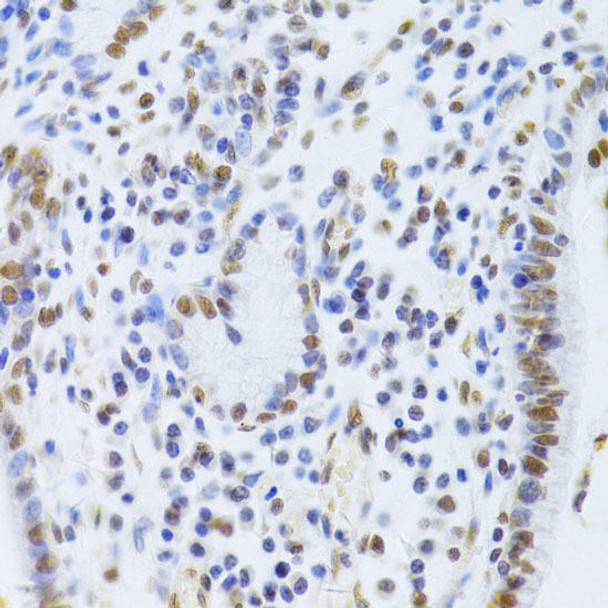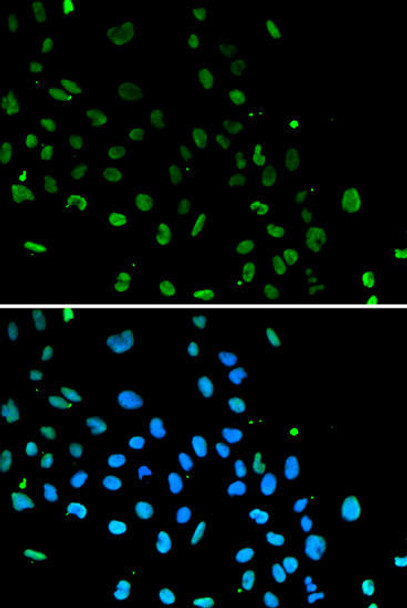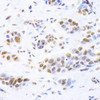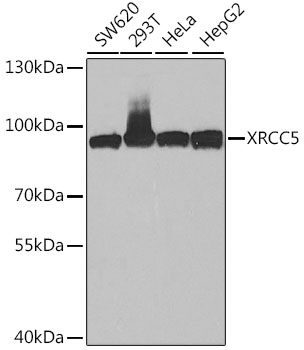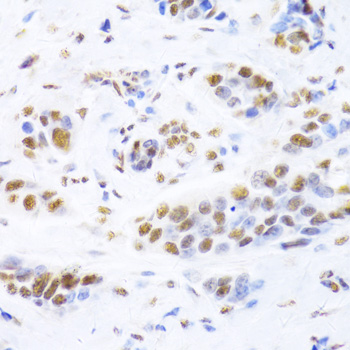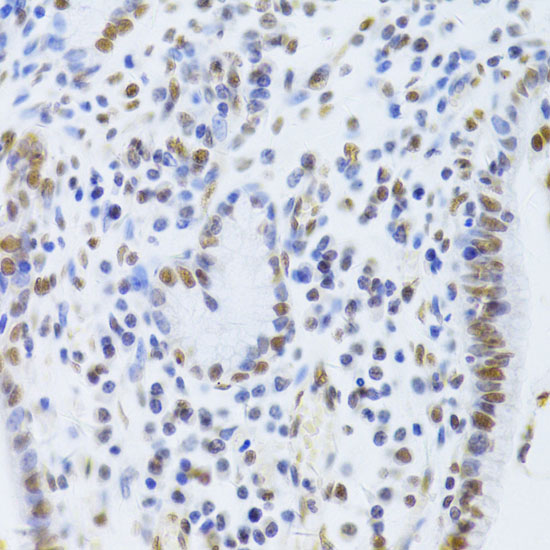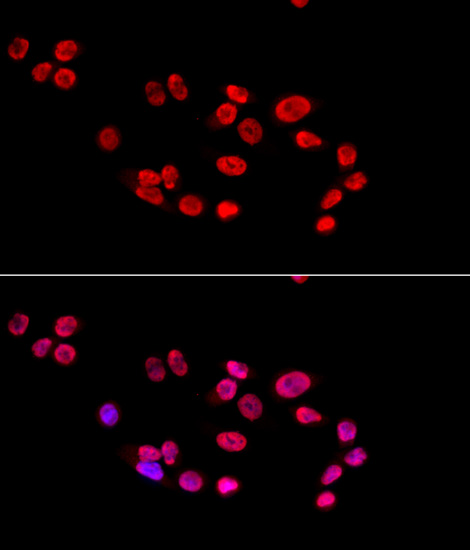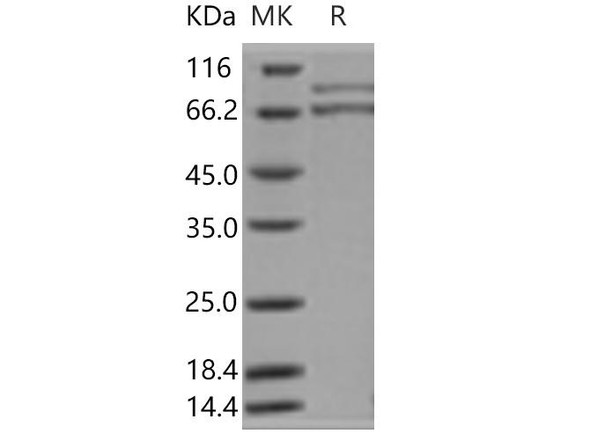Description
Anti-XRCC5 Antibody (CAB5862)
The XRCC5 Polyclonal Antibody (CAB5862) is a valuable tool for research involving XRCC5, a DNA repair protein involved in the non-homologous end-joining pathway. This antibody, produced in rabbits, is highly specific for human samples and has been validated for use in Western blot applications. By binding to the XRCC5 protein, this antibody enables accurate detection and analysis in a variety of cell types, making it suitable for studies in DNA repair mechanisms and cancer research.XRCC5, also known as Ku80, is essential for repairing DNA double-strand breaks and maintaining genomic stability.
Dysregulation of XRCC5 has been implicated in various diseases, including cancer and genetic disorders. As such, understanding the role of XRCC5 in DNA repair processes is crucial for developing targeted therapies for these conditions.Researchers interested in investigating DNA repair pathways and their potential therapeutic applications will find the XRCC5 Polyclonal Antibody to be a valuable asset in their studies. Its high specificity and sensitivity make it a reliable tool for investigating the function of XRCC5 in various biological contexts.
| Antibody Name: | Anti-XRCC5 Antibody |
| Antibody SKU: | CAB5862 |
| Antibody Size: | 20uL, 50uL, 100uL |
| Application: | WB IHC IF IP |
| Reactivity: | Human, Mouse, Rat |
| Host Species: | Rabbit |
| Immunogen: | Recombinant fusion protein containing a sequence corresponding to amino acids 543-732 of human XRCC5 (NP_066964.1). |
| Application: | WB IHC IF IP |
| Recommended Dilution: | WB 1:500 - 1:2000 IHC 1:100 - 1:200 IF 1:20 - 1:100 IP 1:50 - 1:200 |
| Reactivity: | Human, Mouse, Rat |
| Positive Samples: | SW620, 293T, HeLa, HepG2 |
| Immunogen: | Recombinant fusion protein containing a sequence corresponding to amino acids 543-732 of human XRCC5 (NP_066964.1). |
| Purification Method: | Affinity purification |
| Storage Buffer: | Store at -20'C. Avoid freeze / thaw cycles. Buffer: PBS with 0.02% sodium azide, 50% glycerol, pH7.3. |
| Isotype: | IgG |
| Sequence: | KKKD QVTA QEIF QDNH EDGP TAKK LKTE QGGA HFSV SSLA EGSV TSVG SVNP AENF RVLV KQKK ASFE EASN QLIN HIEQ FLDT NETP YFMK SIDC IRAF REEA IKFS EEQR FNNF LKAL QEKV EIKQ LNHF WEIV VQDG ITLI TKEE ASGS SVTA EEAK KFLA PKDK PSGD TAAV FEEG GDVD DLLD MI |
| Gene ID: | 7520 |
| Uniprot: | P13010 |
| Cellular Location: | Chromosome, Nucleus, nucleolus |
| Calculated MW: | 82kDa |
| Observed MW: | 86kDa |
| Synonyms: | XRCC5, KARP-1, KARP1, KU80, KUB2, Ku86, NFIV |
| Background: | The protein encoded by this gene is the 80-kilodalton subunit of the Ku heterodimer protein which is also known as ATP-dependant DNA helicase II or DNA repair protein XRCC5. Ku is the DNA-binding component of the DNA-dependent protein kinase, and it functions together with the DNA ligase IV-XRCC4 complex in the repair of DNA double-strand break by non-homologous end joining and the completion of V(D)J recombination events. This gene functionally complements Chinese hamster xrs-6, a mutant defective in DNA double-strand break repair and in ability to undergo V(D)J recombination. A rare microsatellite polymorphism in this gene is associated with cancer in patients of varying radiosensitivity. |
| UniProt Protein Function: | Ku80: the 80-kilodalton subunit of the Ku complex, also known as ATP-dependant DNA helicase II. A single stranded DNA-dependent ATP-dependent helicase. It functions together with the DNA ligase IV-XRCC4 complex in the repair of DNA double-strand break by non-homologous end joining and the completion of V(D)J recombination events. This gene functionally complements Chinese hamster xrs-6, a mutant defective in DNA double-strand break repair and in ability to undergo V(D)J recombination. A rare microsatellite polymorphism in this gene is associated with cancer in patients of varying radiosensitivity. Has a role in chromosome translocation. The DNA helicase II complex binds preferentially to fork-like ends of double-stranded DNA in a cell cycle-dependent manner. It works in the 3'-5' direction. Binding to DNA may be mediated by p70. |
| UniProt Protein Details: | Protein type:Nucleolus; RNA-binding; DNA-binding; EC 3.6.1.-; Nuclear receptor co-regulator; Helicase; EC 3.6.4.- Chromosomal Location of Human Ortholog: 2q35 Cellular Component: cytosol; membrane; nuclear chromosome, telomeric region; nuclear telomere cap complex; nucleolus; nucleoplasm; nucleus; plasma membrane Molecular Function:5'-deoxyribose-5-phosphate lyase activity; ATP binding; ATP-dependent DNA helicase activity; damaged DNA binding; DNA binding; double-stranded DNA binding; double-stranded telomeric DNA binding; protein binding; protein C-terminus binding; telomeric DNA binding; ubiquitin protein ligase binding Biological Process: cell proliferation; DNA duplex unwinding; DNA recombination; DNA repair; double-strand break repair; double-strand break repair via nonhomologous end joining; innate immune response; negative regulation of transcription, DNA-dependent; positive regulation of interferon type I production; positive regulation of neurogenesis; regulation of smooth muscle cell proliferation; telomere maintenance; transcription, DNA-dependent; viral reproduction |
| NCBI Summary: | The protein encoded by this gene is the 80-kilodalton subunit of the Ku heterodimer protein which is also known as ATP-dependant DNA helicase II or DNA repair protein XRCC5. Ku is the DNA-binding component of the DNA-dependent protein kinase, and it functions together with the DNA ligase IV-XRCC4 complex in the repair of DNA double-strand break by non-homologous end joining and the completion of V(D)J recombination events. This gene functionally complements Chinese hamster xrs-6, a mutant defective in DNA double-strand break repair and in ability to undergo V(D)J recombination. A rare microsatellite polymorphism in this gene is associated with cancer in patients of varying radiosensitivity. [provided by RefSeq, Jul 2008] |
| UniProt Code: | P13010 |
| NCBI GenInfo Identifier: | 125731 |
| NCBI Gene ID: | 7520 |
| NCBI Accession: | P13010.3 |
| UniProt Secondary Accession: | P13010,Q0Z7V0, Q4VBQ5, Q53HH7, Q7M4N0, Q9UCQ0, Q9UCQ1 A8K3X5, |
| UniProt Related Accession: | P13010 |
| Molecular Weight: | 82,705 Da |
| NCBI Full Name: | X-ray repair cross-complementing protein 5 |
| NCBI Synonym Full Names: | X-ray repair complementing defective repair in Chinese hamster cells 5 |
| NCBI Official Symbol: | XRCC5 |
| NCBI Official Synonym Symbols: | KU80; KUB2; Ku86; NFIV; KARP1; KARP-1 |
| NCBI Protein Information: | X-ray repair cross-complementing protein 5 |
| UniProt Protein Name: | X-ray repair cross-complementing protein 5 |
| UniProt Synonym Protein Names: | 86 kDa subunit of Ku antigen; ATP-dependent DNA helicase 2 subunit 2; ATP-dependent DNA helicase II 80 kDa subunit; CTC box-binding factor 85 kDa subunit; CTC85; CTCBF; DNA repair protein XRCC5; Ku80; Ku86; Lupus Ku autoantigen protein p86; Nuclear factor IV; Thyroid-lupus autoantigen; TLAA; X-ray repair complementing defective repair in Chinese hamster cells 5 (double-strand-break rejoining) |
| UniProt Gene Name: | XRCC5 |
| UniProt Entry Name: | XRCC5_HUMAN |



